क्यों बनता है सूर्य और चन्द्र के गिर्द एक प्रकाश वृत्त (प्रभा मंडल ,Halo)?
ये प्रकाश के घेरे सूचना देते हैं सर्वाधिक ऊंचाई पर बनने वाले बर्फीले पक्षाभ मेघों , एक दम से महीन
हिम कण युक्त बादलों की .प्रचंड आंधी तूफानों का पूर्व संकेत समझा जाता है इस प्रकाश के घेरे और बर्फीले
बादल को .
विज्ञानी इस वृत्त को Halo कहते हैं . दुनिया भर में लोग ऐसे Halos देखे जाने की इतल्ला वर्ष भर देते रहते हैं
.गत दिनों ऐसा ही एक वृत्त देखे जाने की इतल्ला नाम चीन ब्लोगर डॉ .अरविन्द मिश्र जी ने भी अपने ब्लॉग
पर दी .इस खबर को जागरण प्रकाशन ने छापा .
हुर्रिकैन सैंडी के देखे जाने की पूर्व संध्या पर अमरीका के पूर्वी तट पर इन घेरों को कौतुक के साथ देखा गया था
.अमरीका के मध्यपश्चिम और पश्चिमी तटबंध वासियों ने भी इन्हें देखा .
दुनिया भर की दंत कथाओं में इन घेरों को वर्षा का अग्र दूत समझा गया है ऐसी वर्षा जो अपने साथ गर्जन
तूफ़ान लिए आती है . जनमानस में यह पक्षाभ मेघ भय और कौतुक का सबब बने हैं .
20,000 फीट या और भी अधिक ऊंचाई पर बने ये पक्षाभ मेघ नन्ने हिम क्रिस्टलों से लदे रहतें हैं .ये हिम
मणिभ न सिर्फ चन्द्र प्रकाश का वर्तन (प्रकाश को सरल रेखा मार्ग से मोड़ देना ) करतें हैं ,परावर्तन और
प्रकीर्णन(Scattering) भी कर देते हैं ,प्रकाश को उसके विविध रंगों के अनुरूप तोड़ देते हैं ,विचलित भी कर देतें
हैं .इन तीनों
का मिला जुला प्रभाव प्रभामंडल रचता है बशर्ते क्रिस्टल अन्तरिक्ष में एक ख़ास अनुस्थापन और अभिविन्यास
लिए हों ,एक ख़ास दिशा में समायोजित हों ,रखें हों ,तब ही हम इन अन्तरिक्ष पिंडों के गिर्द Halo देख पाते हैं .
अभिविन्यास के अनुरूप ही ये हर observer को जुदा अंदाज़ दिखाई देतें हैं .
हमारी लोक परम्परा और लोक साहित्य में कवि घाघ और घड्दरी ने मौसम विज्ञान का पक्षी ध्वनी
आधारित अध्ययन अपनी काव्य लोकोक्तियों में किया है .चन्द्र और सूर्य प्रभा का भी उल्लेख किया है .
रविकर ने कहा…
चार दिनों से झेलता, झारखण्ड बरसात |
नीलम का यह असर है, चलता झंझावात |
चलता झंझावात, उपग्रह है प्राकृतिक |
दर्पण सा अवलोक, गगन से घटना हर इक |
हुवे घाघ अति श्रेष्ठ, पढ़ें संकेत अनोखे |
करे आकलन शुद्ध, मिलें फल हरदम चोखे ||
A ring or circle of light around the sun or moon is called a halo by scientists. We get many messages throughout each year from people who’ve just spotted a ring around the sun or moon. The night before Hurricane Sandy made landfall on the U.S. mainland on October 29, 2012, for example, many on the U.S. East Coast saw a lunar halo. The night of the landfall itself, as clouds from Sandy covered the U.S. East, many in the U.S. Midwest and West saw a halo. We do not know if Sandy was responsible for these halos, but in fact lunar and solar halos are associated with nearby storms. Solar and lunar haloes are pretty common, but they’re so mysterious-looking that people often express amazement upon seeing them. They want to know: what causes a halo around the sun or moon?
Order your 2013 moon calendar today.
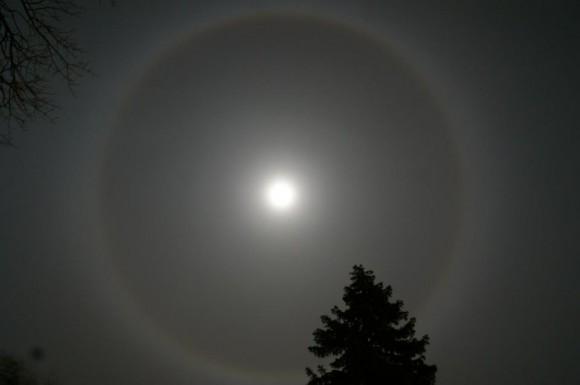

There’s an old weather saying: ring around the moon means rain soon. There’s truth to this saying, because high cirrus clouds often come before a storm. Notice in these photos that the sky looks fairly clear. After all, you can see the sun or moon. And yet halos are a sign of high thin cirrus clouds drifting 20,000 feet or more above our heads.
These clouds contain millions of tiny ice crystals. The halos you see are caused by both refraction, or splitting of light, and also by reflection, or glints of light from these ice crystals. The crystals have to be oriented and positioned just so with respect to your eye, in order for the halo to appear.
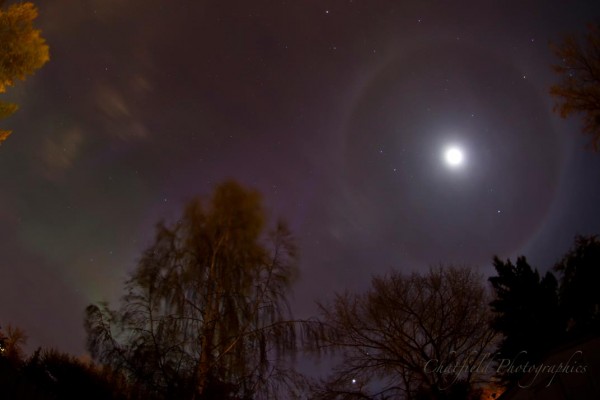
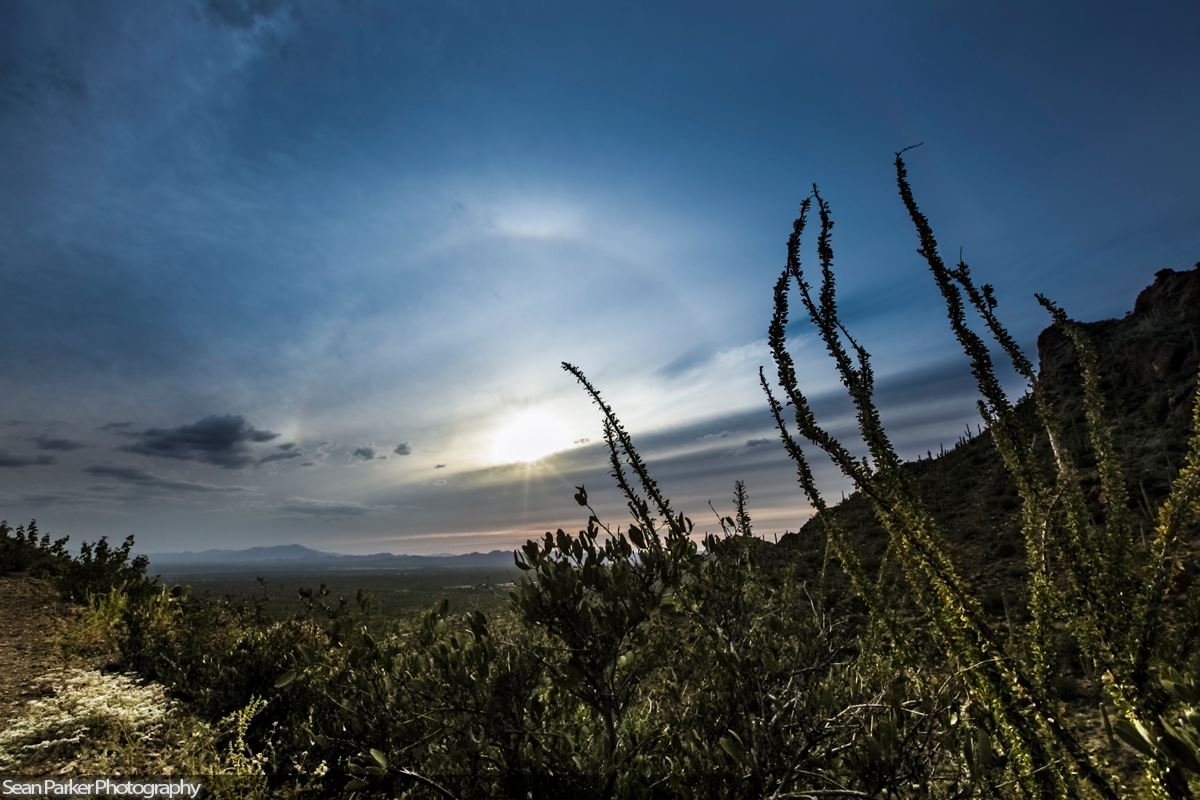
That’s why, like rainbows, halos around the sun – or moon – are personal. Everyone sees their own particular halo, made by their own particular ice crystals, which are different from the ice crystals making the halo of the person standing next to you.
Because moonlight isn’t very bright, lunar halos are mostly colorless, but you might notice more red on the inside and more blue on the outside of the halo. These colors are more noticeable in halos around the sun. If you do see a halo around the moon or sun, notice that the inner edge is sharp, while the outer edge is more diffuse. Also, notice that the sky surrounding the halo is darker than the rest of the sky.
Bottom line: Halos around the sun or moon happen when high, thin cirrus clouds are drifting high above your head. Tiny ice crystals in Earth’s atmosphere cause the halos. They do this by refracting and reflecting the light. Lunar halos are signs that storms are nearby.
Learn more about halos at Les Cowley’s great website Atmospheric Optics
ये प्रकाश के घेरे सूचना देते हैं सर्वाधिक ऊंचाई पर बनने वाले बर्फीले पक्षाभ मेघों , एक दम से महीन
हिम कण युक्त बादलों की .प्रचंड आंधी तूफानों का पूर्व संकेत समझा जाता है इस प्रकाश के घेरे और बर्फीले
बादल को .
विज्ञानी इस वृत्त को Halo कहते हैं . दुनिया भर में लोग ऐसे Halos देखे जाने की इतल्ला वर्ष भर देते रहते हैं
.गत दिनों ऐसा ही एक वृत्त देखे जाने की इतल्ला नाम चीन ब्लोगर डॉ .अरविन्द मिश्र जी ने भी अपने ब्लॉग
पर दी .इस खबर को जागरण प्रकाशन ने छापा .
हुर्रिकैन सैंडी के देखे जाने की पूर्व संध्या पर अमरीका के पूर्वी तट पर इन घेरों को कौतुक के साथ देखा गया था
.अमरीका के मध्यपश्चिम और पश्चिमी तटबंध वासियों ने भी इन्हें देखा .
दुनिया भर की दंत कथाओं में इन घेरों को वर्षा का अग्र दूत समझा गया है ऐसी वर्षा जो अपने साथ गर्जन
तूफ़ान लिए आती है . जनमानस में यह पक्षाभ मेघ भय और कौतुक का सबब बने हैं .
20,000 फीट या और भी अधिक ऊंचाई पर बने ये पक्षाभ मेघ नन्ने हिम क्रिस्टलों से लदे रहतें हैं .ये हिम
मणिभ न सिर्फ चन्द्र प्रकाश का वर्तन (प्रकाश को सरल रेखा मार्ग से मोड़ देना ) करतें हैं ,परावर्तन और
प्रकीर्णन(Scattering) भी कर देते हैं ,प्रकाश को उसके विविध रंगों के अनुरूप तोड़ देते हैं ,विचलित भी कर देतें
हैं .इन तीनों
का मिला जुला प्रभाव प्रभामंडल रचता है बशर्ते क्रिस्टल अन्तरिक्ष में एक ख़ास अनुस्थापन और अभिविन्यास
लिए हों ,एक ख़ास दिशा में समायोजित हों ,रखें हों ,तब ही हम इन अन्तरिक्ष पिंडों के गिर्द Halo देख पाते हैं .
अभिविन्यास के अनुरूप ही ये हर observer को जुदा अंदाज़ दिखाई देतें हैं .
हमारी लोक परम्परा और लोक साहित्य में कवि घाघ और घड्दरी ने मौसम विज्ञान का पक्षी ध्वनी
आधारित अध्ययन अपनी काव्य लोकोक्तियों में किया है .चन्द्र और सूर्य प्रभा का भी उल्लेख किया है .
रविकर ने कहा…
चार दिनों से झेलता, झारखण्ड बरसात |
नीलम का यह असर है, चलता झंझावात |
चलता झंझावात, उपग्रह है प्राकृतिक |
दर्पण सा अवलोक, गगन से घटना हर इक |
हुवे घाघ अति श्रेष्ठ, पढ़ें संकेत अनोखे |
करे आकलन शुद्ध, मिलें फल हरदम चोखे ||
EarthSky Oct 30, 2012
What makes a halo around the sun or moon?
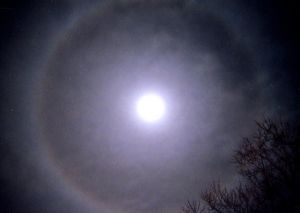 |
|
Order your 2013 moon calendar today.

EarthSky Facebook friend Randy Miller in Anderson, Indiana saw this lunar halo on the night Sandy made landfall on the U.S. mainland, October 29, 2012.

On the night Sandy made landfall, lunar halos were seen as far west in the U.S. as the state of Washington. EarthSky Facebook friend Susan Jensen in Odessa, Washington saw and photographed this delicate halo, as Sandy was carving its path of destruction along the U.S. East Coast.
These clouds contain millions of tiny ice crystals. The halos you see are caused by both refraction, or splitting of light, and also by reflection, or glints of light from these ice crystals. The crystals have to be oriented and positioned just so with respect to your eye, in order for the halo to appear.

Lunar halo – with greenish northern lights on the left – as seen on the morning of October 8, 2012 by EarthSky Facebook friend Colin Chatfield in Saskatoon, Saskatchewan, Canada.

Sun halo seen in Tucson, Arizona on September 27, 2012 by EarthSky Facebook friend Sean Parker Photography. Thank you, Sean! Click here to expand image. More from Sean here.
Because moonlight isn’t very bright, lunar halos are mostly colorless, but you might notice more red on the inside and more blue on the outside of the halo. These colors are more noticeable in halos around the sun. If you do see a halo around the moon or sun, notice that the inner edge is sharp, while the outer edge is more diffuse. Also, notice that the sky surrounding the halo is darker than the rest of the sky.
Bottom line: Halos around the sun or moon happen when high, thin cirrus clouds are drifting high above your head. Tiny ice crystals in Earth’s atmosphere cause the halos. They do this by refracting and reflecting the light. Lunar halos are signs that storms are nearby.
Learn more about halos at Les Cowley’s great website Atmospheric Optics
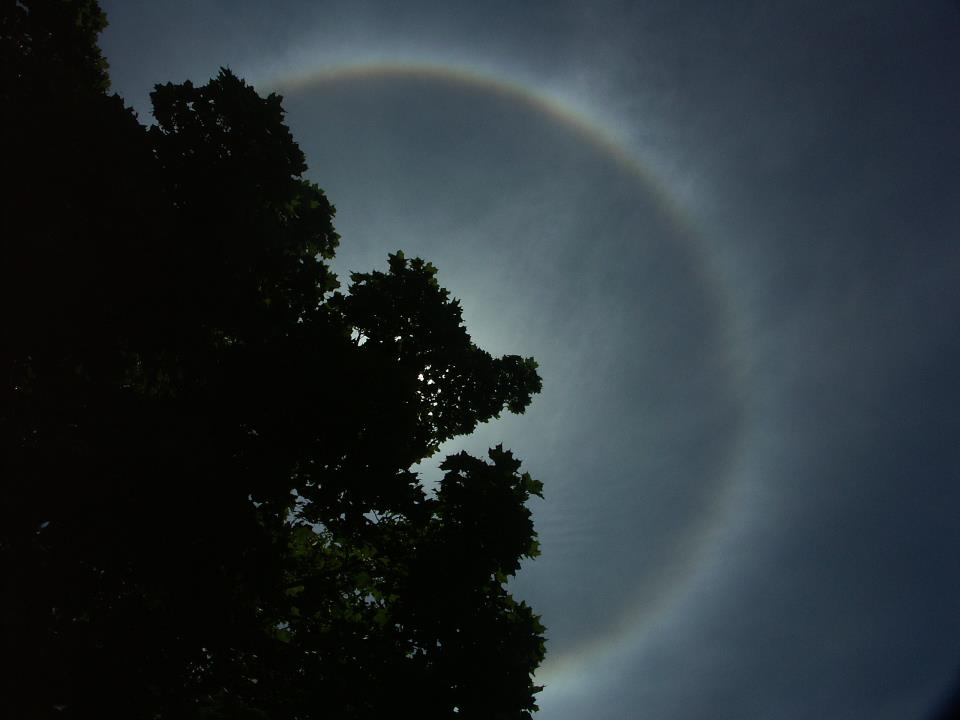
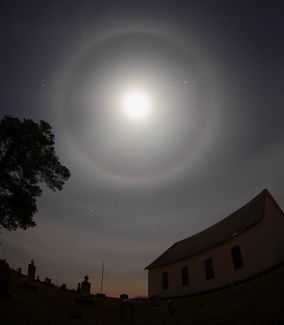
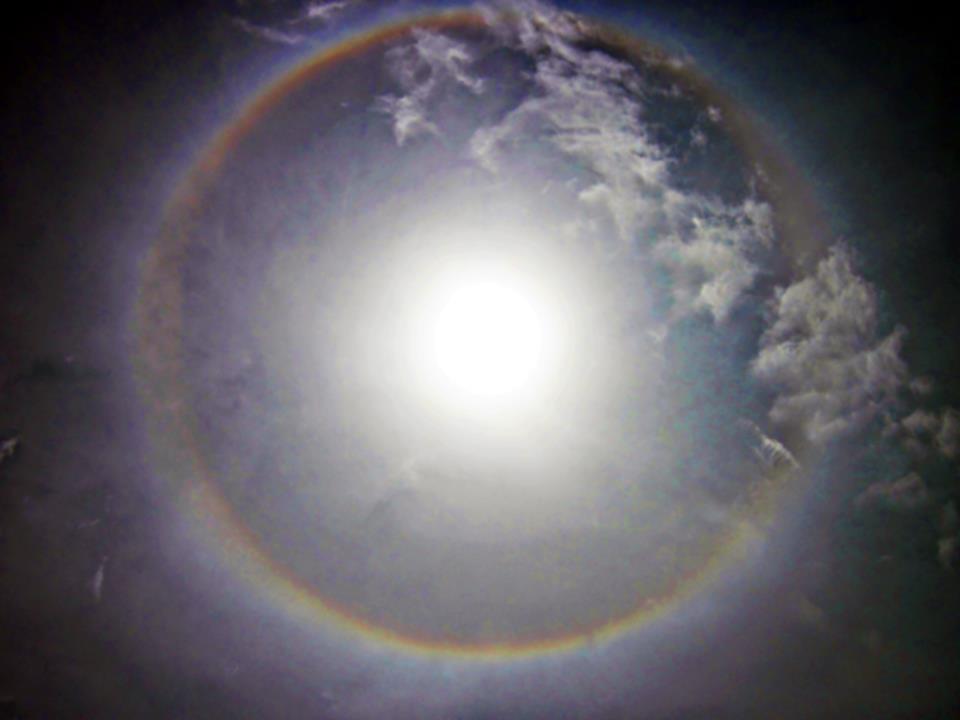
12 टिप्पणियां:
प्रकृति का अद्भुत स्वरूप
सुन्दर व्याख्या ||
चार दिनों से झेलता, झारखण्ड बरसात |
नीलम का यह असर है, चलता झंझावात |
चलता झंझावात, उपग्रह है प्राकृतिक |
दर्पण सा अवलोक, गगन से घटना हर इक |
हुवे घाघ अति श्रेष्ठ, पढ़ें संकेत अनोखे |
करे आकलन शुद्ध, मिलें फल हरदम चोखे ||
I cant forget that awe inspiring scene of 1/2 night of instant.
You havd presented a complete info on this phenomenon.Thanks!
उत्कृष्ट प्रस्तुति का लिंक लिंक-लिक्खाड़ पर है ।।
आज लिंक लिक्खाड़ पर
450 वीं
पोस्ट
घाघ और घड्दरी हमारे दो जन कवि एवं मौसम विज्ञान के माहिरों ने पक्षियों की ध्वनियों पर काम किया था .इनकी काव्य
उक्तियाँ भविष्य कथन होते थे .चन्द्र प्रभा पर भी इन्होनें लिखा है .
घाघ और घड्दरी हमारे दो जन कवि एवं मौसम विज्ञान के माहिरों ने पक्षियों की ध्वनियों पर काम किया था .इनकी काव्य
उक्तियाँ भविष्य कथन होते थे .चन्द्र प्रभा पर भी इन्होनें लिखा है .
घाघ और घड्दरी हमारे दो जन कवि एवं मौसम विज्ञान के माहिरों ने पक्षियों की ध्वनियों पर काम किया था .इनकी काव्य
उक्तियाँ भविष्य कथन होते थे .चन्द्र प्रभा पर भी इन्होनें लिखा है .
ज्ञान वर्द्धक पोस्ट.
मेरी नई पोस्ट पर आपका स्वागत हैं ...
http://rohitasghorela.blogspot.in/2012/11/blog-post_6.html
Deshagaman par aapka swagat, behad rochak aur gyanvardhak prastuti,
काफी जानकारी दी ..... नज़ारे तो सच में अद्भुत है ....
प्रकृति में जो कुछ घटनेवाला है उसके लक्षणों से पूर्वाभास मिल जाता है - निरीक्षण करनेवाला चाहिये !! .
बहुत ही अच्छी जानकारी देता यह आलेख ... आभार
एक टिप्पणी भेजें